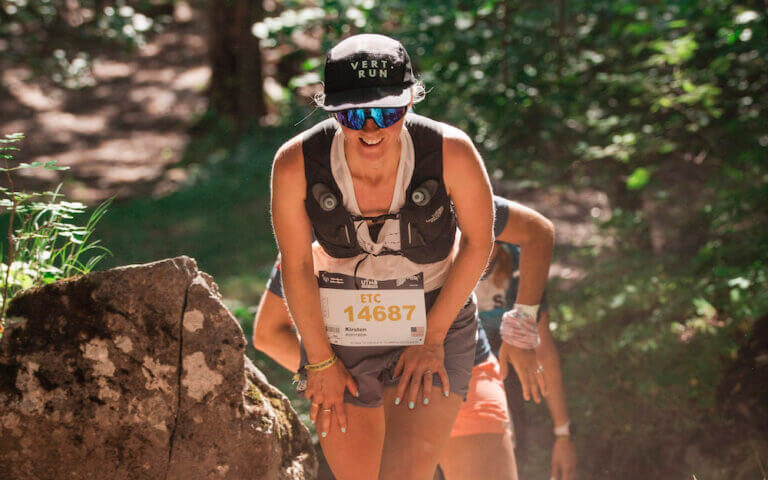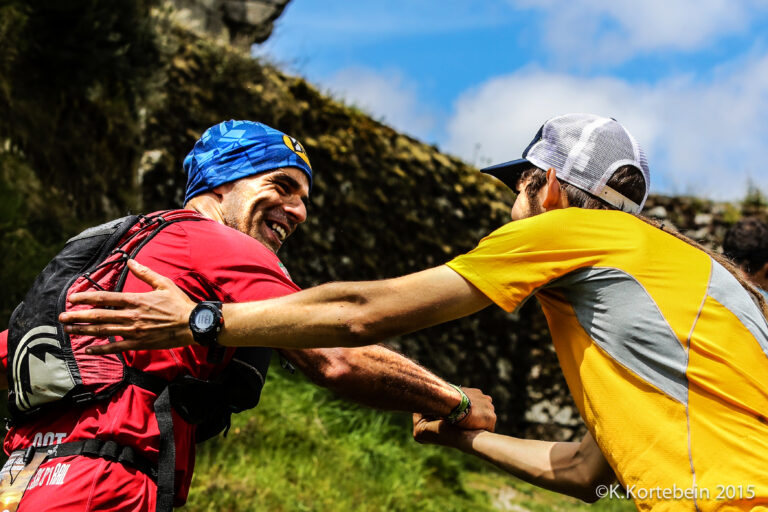Back-to-back trainings are done for two main reasons. Firstly, back-to-backs build your endurance; secondly, they increase your tolerance for long hours of running, and teach your body and mind how to run on tired legs (this is especially useful in race prep.) Of course, as with any type of intense training, there are both potential risks and rewards–but we strongly believe that when you do back-to-back trainings correctly, safely and with structure, that they’ll be incredibly helpful for you.
So. What’s a back-to-back training, exactly?
Basically, it’s having two long workouts on two consecutive days. They also work for those of you who are training for shorter distances; it’s not just ultra runners who can benefit from back-to-backs.
Here’s an example of how a back-to-back training would look if you’re training for a half marathon. Your race will be 21k; so, to improve your endurance, we’d have you do two separate workouts of 10-12 kilometers each (one on each day.) Plus, we’d have you finish the second workout by doing a tempo run or some fartleks. Why, you might ask, would we do this to you? It’s to simulate the fatigue that you’ll feel during a race (especially towards the end), and to teach your mind to “dig deep” and to find strength to keep moving forward.
The same logic would apply when doing back-to-back trainings in preparing for a trail marathon or a 50k. A back-to-back for these distances might look like having one 2-3 hour run on Saturday, and another 2-3 hour run on Sunday.
The idea is that during your back-to-back training, you’ll feel how you will at the end of your race–without having to actually run the whole race distance to get to that feeling. This makes back-to-backs an especially great time to test your race nutrition, gear, recovery tactics, race strategy, and mental strength.
If you’re training for an even longer race, back-to-back trainings are still an awesome tool. In training for the Ultra Trail du Mont Blanc (UTMB), for example, we assign our athletes a four-day training block of back-to-backs. During these days, they cover the race course in four parts, and work on maintaining consistency and finishing strong. This allows them to both get to know the course, and to understand the “real” effort they’ll have to put in via one push during the race itself…and this is a huge way to build mental strength before an ultramarathon. To sum it up: back-to-back trainings (or back-to-back to back-to-back) can be adjusted to fit each race’s training plan, no matter how long the distance you’re training for.

Another great way to do back-to-back trainings is to do an intensity workout on the first day, and a long run on the second day. Doing it this way is especially good if you’re a busy trail runner (it takes less time than a “traditional” back-to-back training) because you’ll be just as tired–if not more tired–on the second day than you would by just doing two long runs.
Now we’ll walk through the important part: understanding how to do back-to-back trainings safely. Then, we’ll go through some key tips about how to get the most out of these trainings.
Cons and possible risks of back-to-back trainings:
Risk: Injury: If your training plan tells you to do a back-to-back training–or, if you decide to do one on your own–it’s important to be aware that the more we run on tired legs, the higher our risk of injury. Why is this? It’s because the more tired we become, the more we start to lose our correct running form. Plus, when we’re tired, we start to accumulate stress on muscles and joints that wouldn’t be so fatigued by a “normal” training. So, what’s the key to avoiding injury when doing back-to-backs? Being extremely attentive to how your body feels, and listening to it. If you start the first day of back-to-back training with some small discomfort but don’t listen to your body, it can become a real injury by the end of the second day. It’s crucial to hit the brakes when your body’s saying “no,” and this applies to all trainings–not just back-to-backs.
Con: you’ll need longer to recover than after a normal long run: By the end of a back-to-back training, you’ll definitely feel more tired than normal. In fact, you’ll probably feel the way you would after a race. So, it’s important to dedicate extra recovery time that’s proportional to the effort of your training. This extra recovery time might mean that you’ll have to recognize that you might lose a couple “normal” training days after doing a back-to-back. Respect this, and respect your body. Also, make sure to pay attention to/note your overall energy level in the days after your back-to-back so you begin to learn more about your body.
Con: back-to-back trainings are time consuming: The more you run, the more time it takes. This is pretty obvious, but it’s especially noticeable with back-to-back trainings. One of the biggest inconveniences of these trainings is the chunk of time they consume; this is something that I, as a professional trail runner, also struggle with. It’s hard to dedicate two days, especially over a weekend, to two long trainings. One way to make it feel less like you’re “losing two days” is to wake up extra early, and get the training out of the way. Or, when training for really long races (like the UTMB example from before) it’s almost better to just “block off” the whole series of days and dedicate them to training for your race. Again, we know it’s not easy–it’s hard for all of us to dedicate the time to back-to-backs, but when you finish your race feeling strong, you’ll be glad you did it.

Best practices for back-to-back trainings:
Recovery: The best way to think about recovery during a back-to-back training is: “the recovery process for your second day starts during the last miles of your first day of the training.” What do we mean by this? Well, the more tired or destroyed that you finish the first day, the harder the second day’s training will be–so, make sure you’re eating and hydrating well throughout your first day’s training. Then, as soon as you finish the first day’s workout, refuel and rehydrate as soon as you can–and with the best nutrients possible. Prioritize eating good, high-quality food; making sure you’re hitting your vitamin and mineral quotas; and replacing the calories that you’ve just spent during your hard training. Another tip: a great time for a nap is after your first day of a back-to-back training. This will really help you recover for your second day.
Have you ever tough of training with the guide of the best trail runners in the world.
Use your energy wisely: This tip not only applies to your back-to-back trainings, but to your races, too. To finish strong, you’ll need to be smart with how and when you spend your energy. The way to do this is to learn to pace yourself. (This is one of the reasons that we have our athletes train with a Perceived Effort Scale.) The end of a race is when we most need to be strong–when you finish strong, you’ve got a big advantage because the end of the race is when everyone else feels weak. If you’re able to finish your race running instead of walking, you’ll get a big confidence boost from passing other racers, and will finish with a huge sense of accomplishment. So, during your back-to-back trainings, make sure that you start slow and easy on the first day–and then, finish with strength and consistency on the second day. Sometimes I do the same loop on both days during my back-to-back trainings. In my case, let’s say that I choose a 20-mile loop in preparation for a long race. Even if it’s hard, I try to make the second day stronger and faster than the first. It’s important to note that this won’t always be possible; it’s hard to do, but the good news is that then we can see where we need to improve. It’s also a great test to measure our training progress.
Step up your mental game: Get ready to push hard, dig deep, learn about yourself and to understand your fitness during back-to-back trainings. These trainings are a real mental test, so you should prepare accordingly. Some good tips are: get a good night’s sleep the night before; make yourself a great playlist for during the training; pick out a good podcast or audiobook to listen to; and to bring “treats” for during your run (snacks that will keep your energy up, but that you also enjoy eating so that you’ll have something small to look forward to.) Most importantly, at the end of the block, reward yourself for your hard work: have a nice dessert, take a bath, watch a good movie, have dinner with friends, enjoy a beverage of your choice, etc.

Organize yourself: Planning is key to making back-to-back trainings easier on you. Plan where you’ll run, when you’ll run, what you’ll eat and what you’ll wear. The more that you organize in advance, the more simple the training itself will be. This will let you focus on what matters most: running, and listening to your body. Sometimes, it’s actually even best to choose simple routes or to do loops during these training sessions. (This can help you become more aware of how your body feels, and to have a good sense of your speed.) If this is one of your first back-to-back trainings, try to keep it simple. You can always get more creative over time.
Play it safe: Don’t go wild when deciding where to do this training. Don’t choose routes or places where if something goes wrong or you crash energy-wise that are difficult to get out of. There’s no need to take extra risk. Plus, when you keep things simple, you don’t have to spend extra energy worrying about getting lost or focusing too hard on the terrain. Don’t overshoot the time assigned in your training plan; accept your limitations and experience level; and understand that the more you keep yourself safe, the more you’ll be able to keep exploring in the future.
Be ready not to finish: This might sound a bit counterintuitive, but a big part of practicing safety during trail running is knowing when to call it quits. This applies to your back-to-back trainings just as much as it does when running in wild backcountry. If you’re having pain or are low in energy during your back-to-back, remember that it’s ok to stop. Really. This is just a training run. Sometimes it’s better to save our energy and mental strength for the race itself, so remember to take it easy and not to surpass your safety limits.
In our Vert.run training plans, we do sometimes assign back-to-back workouts. This doesn’t mean that we assign them frequently, or randomly–in fact, it’s the opposite.
These types of workouts are specific and should be done only under certain circumstances. That’s why they’re more present in plans like our “Build Endurance” training block, or our Premium Plans when you’re training for long ultramarathons.
A big reason that we founded Vert.run was to offer affordable training plans for those who can’t pay for a private coach. We believe that everyone deserves access to guidance and should learn to train responsibly and safely. Remember that “more” doesn’t always mean “better” when it comes to trail running–the more you listen to your body and respect it, the more it will pay you back with a lifetime of running.
Train for your next trail race was never so easy.








